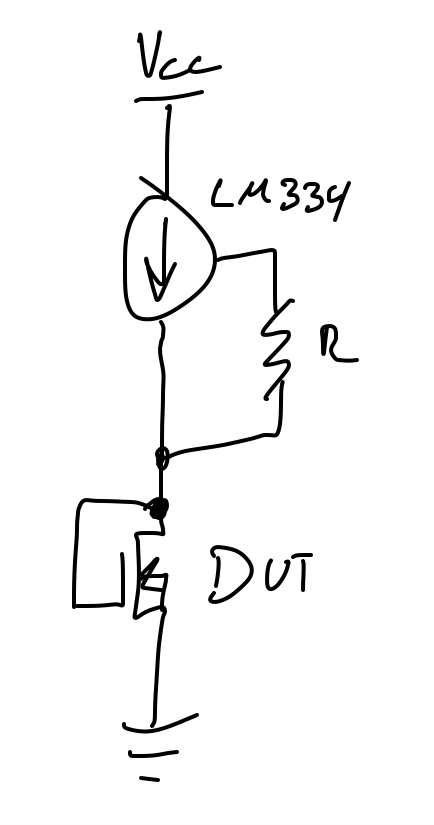Hello, we are making a thesis where we use MOSFETs as an alternative radiation detector. So to explain it, it works when the mosfet is irradiated with an external radiation source; its voltage threshold increases, which will be used to determine the radiation dose. I’m currently asking for help on how we measure the voltage threshold. BTW, we are using an n-channel MOSFET (model: IRFP250NPbF). Also in the datasheet provided by the manufacturer, it says here VGS(th)/Gate Threshold Voltage Min: 2.0 ––– Max: 4.0 V. There is a condition here with VDS = VGS, ID = 250 A. Does this mean that to measure the VGS, we need to first satisfy the conditions? To measure the voltage threshold, what node will we use to measure the VGS (th)? Is it at the drain to the source terminal or still at the gate to the source terminal? Feel free to share your thoughts, if you have any. I would also like to add that we have already tried to supply a voltage at the gate with respect to the source terminal. We use a 4 V supply voltage, and when we tried to measure the VDS (drain to source voltage), there was a voltage drop, so we’ve got a 3.5 V. Also, we are using an Arduino to measure its voltage and a multimeter for checking.
Using MOSFETs as TID sensors is common enough. A term that you can use for more research is RADFET. The best way to measure threshold voltage is to sweep the gate voltage. In my experience however, if you intend to measure this in a non-lab environment (say, in a satellite), I would recommend that you instead connect the gate to the drain, force a small constant current (maybe 10uA) from the drain to source, and measure Vds (which is equal to Vgs in this configuration). This won’t give you the threshold voltage per se, but this will produce a voltage that changes as dose accumulates, is a far easier metric to measure, and is as equally valid as measuring the threshold voltage to determine TID. You can’t really predict the shift in threshold voltage according to TID unless your MOSFETs are all from the same batch (manufacturing defects and tolerances), and you need to calibrate them in order to obtain a calibration curve (this is done by simply going to irradiate several (the more the better, I suggest at least 10 for statistical significance). Alternatively, you can buy pre-calibrated ones from companies who make MOSFETs for this intended purpose like Varadis. If you really want to measure the threshold voltage, you could read MIL-STD-750, which outlines how to measure the threshold voltage.
Hello, do i still need to apply a supply voltage of Vgs, or will only the current at the drain be the main source. Also, is this MOSFET sensitive enough for a cs-137 (661 keV).
Ultimately, yes you will need to bias the gate. If you put the MOSFET in the diode connection mode, the gate will automatically be biased when you force a constant Ids current. While I have never worked with this MOSFET nor with Cs137, I don’t see why it wouldn’t be sensitive. A few notes:
- This MOSFET is in a TO-247 package, so make sure that you have the front of the MOSFET pointed towards the Cs137 source during irradiation, otherwise the leadframe will likely act as an attenuator, reducing the sensitivity.
- This MOSFET is a HEXFET, which normally aren’t designed for continuous high DC power dissipation (they are meant for switching). So keeping the dissipated power in the FET would be best.
- I’m not sure if there is a difference in general sensitivity between HEXFETs and other MOSFET types like VDMOS or traditional monolithic planar MOSFETs.
- I’m not sure if you already planned this, put generally it is recommended for the MOSFET to have all pins grounded during irradiation. Biasing of the MOSFET can affect its sensitivity (depends on every MOSFET), so having all pins grounded keeps them in a constant state during irradiation (and lets all accumulated charge get shunted to ground, preventing ESD damage).
I’m using lm334z as a current source, i’m still thinking and deciding on where to connect it to the MOSFET. Can you propose the wiring for the current source input once the MOSFET is in diode connection. Like for example, in a breadboard i used a wire to connect the drain and gate. then, i’ve applied a constant current at drain terminal with source connected to the negative. So to check the change in voltage, should i measure the voltage in Gate to source?
The wiring is simple enough, see image. Since the gate is connected to the drain, you can measure either Vds or Vgs. They are equal in this configuration so it doesn’t matter.

Hello, I have already tried to apply a microampere current (around 40 μA) using only Ohm’s law. I used a 2V input and a resistor in series. However, the LM334z is not working, and I am unsure of the reason for its failure. Will using an input voltage and a resistor in series work just fine?
I have also measured the Vgs, which reads at around 0.117 mV. What do you think about the measured Vgs? Technically, it should be around these values, right? Considering that there is a very small current.
You will probably need to increase your voltage. I haven’t ever used the LM334, but it will need a minimum voltage across it. I don’t know if you are still using the IRFP250N, but if so it has a threshold somewhere between 2V and 4V for 250uA, so the threshold won’t be as high but it should be close. I would try using 5V if it’s fine with your setup.
For the suitability of the resistor method, you should do the math on how a change in Vds will affect the current, and then calculate how much this variability in current will affect your readings. If this error/innacuracy is acceptable, then why not.
I just want to ask some points:
- Do you mean that to properly operate the LM334, we need to apply or reached the threshold voltage of the MOSFET which is around (2 and 4V)? But, i’ve tried to used it (LM334z) as a standalone and still it doesn’t work. maybe the LM334z is the problem hahaha *Regarding the resistor method, What do you think about the measured Vds, Vds=117mV (With an input current of 40uA)? i’m confused with the “how a change in Vds will affect the current” *Isn’t it Vds the parameter required for determining the dose? So if there is a constant current and resistance, how does the radiation affects the MOSFET? Will resistance or current increase upon irradiation leading to an increase in the measured Vds?
Also i’m using a TO-92 package for a MOSFET, so is there any tips on the orientation during the irradiation.
I’m not entirely sure, but I suspect that the die is mounted to the leadframe on the flat side of the package. In this case you should point the flat side towards the source.
Hey I messaged them a bit, this is an undergraduate project with no budget (so a MOSFET tester is out of budget). I also suggested a sort of sweep method using an MCU and some op-amp glue, but I don’t think they have sufficient background to get this kind of thing working yet (in fact I barely do, so probably it won’t ‘just work’ with whatever I came up with off the top of my head).
What I was thinking is perhaps they can set Vds and Vgs to fixed values such that a particular MOSFET conducts a fixed current, e.g. 100mA, somewhere near-ish the start of the linear region. Then record the Vgs required to achieve this current for each of a set of MOSFETs, say a few dozen (because of part variation).
Then after exposing them to varying amounts of radiation (a few for each exposure level), put them back in the same test conditions and measure how the output current has changed, what Vgs will restore the same current, draw some graphs, discuss the advantages and disadvantages relative to the Vth method with regards to radiation dosimetry, conclude, and call it a day.
Think it would work? No need for an MCU or signals processing this way, so the science can get done with the tools they have.
Also I never had free access to strong radiations sources in undergrad, so am a little jealous. I barely got to use tritium, and that sparingly.
Connect the gate to a function generator via a series resistor. (Gnd on the source pin) Drive it with a square wave 0v low 5+v high and observe the gate voltage on the oscilloscope. You will see a little plateau spot in the waveform, this is at the gate threshold voltage.

Interesting, I’ve never thought of doing it exactly this way. Usually I see high surface area PIN junctions used to detect particle impact either by reverse biasing the junction or by directly measuring induced voltage. The amplification stage is not so easy. This is for particle counting and energy measurement though.
What kind of radiation are you measuring? Gamma I guess?
I guess the first thing that comes to mind is that for a given signal, as Vgs increases perhaps the on-resistance at a given voltage does too? If so, it might be easy to measure the voltage drop across the MOSFET on resistance and how it changes with dose.
If I think of anything else though, I’ll let you know!
Edit: I suppose you could also use an R/2R network to provide an increasing voltage to the MOSFET base, and measure the point where the output reaches some threshold, a direct measurement of Vgs. That should be pretty easy using one full output port of an Arduino and one of the ADCs.
You could try connecting a current source to the source of the FET, connect the gate to a voltage reference, and connect the drain to a supply. Then the gate source voltage will be kept at threshold at all times and can be measured with a difference amplifier.
This could be done with a couple of op-amps provided they aren’t adversely affected by the radiation.
Edit: Looks like blarbasaurus beat me to it.


